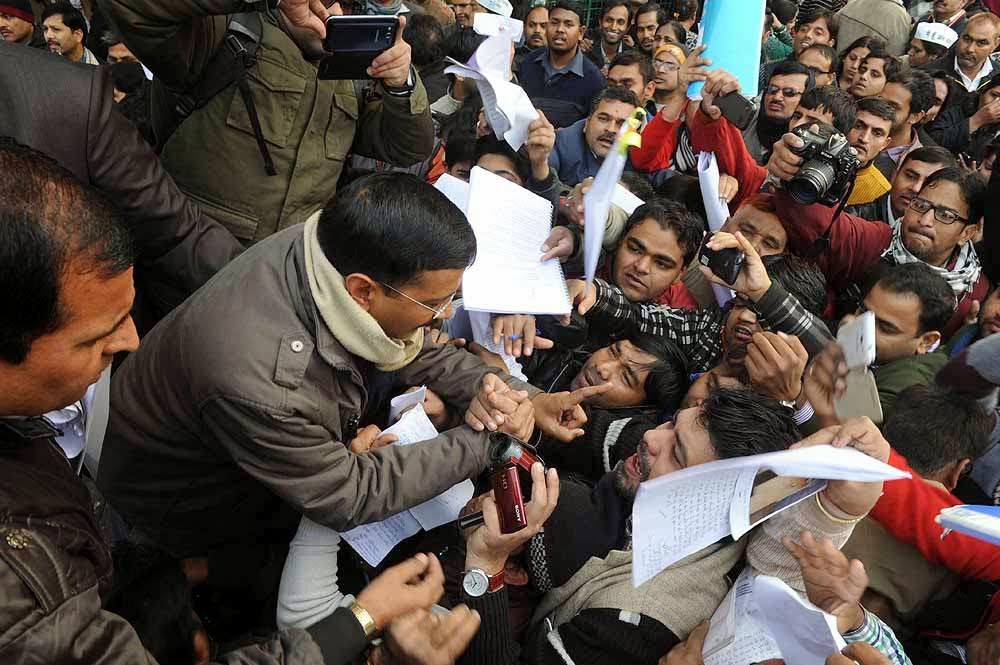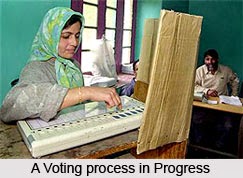The feudal symbolism of Janata Durbars
Janata Durbar traces its history to Dewan-e-aam held during
Mughal times and its name to the Dilli Durbar of 1903. Dewan-e-aam was Emperor’s court, the place & occasion
where the emperor would come, dressed in all their finery & jewellery, with
durbaris , fiefs, vassal & bhands in attendance, to give a public a view of
royal spectacle, to listen to the problems of common citizen and give instant
justice.
Janata, in that context were the
poor, suppressed, emasculated citizenry coming to Durbar hoping that the
benevolent emperor would listen to their problems, be just to them and also of
getting a good look at the royal grandeur. Some would come with requests for waiver of
taxes, some complaining against some minor revenue official and some for
settling petty disputes.
 |
| A scene from Janata Durbar |
At the end of it, the emperor
would go back to palace gloating over his benevolence & sense of justice, having done his rajdharma. Common citizen would walk back home content at
having been heard, instant justice given, unhappy if his request was not met but
nevertheless, swelling with pride at having rubbed shoulders with powers that
be.
Janata Durbar, the two words
themselves symbolize an interaction between two mandatory classes, a ruler
which wants to grant to itself, the role of bestower and an emasculated &
deprived Janata content with pleading, begging and getting alms.
Essentially, Durbar was the place
& occasion where two classes, ruler and the ruled, the king and the pauper,
the rich and the impoverished would uncomfortably interact with each other and
go back to their respective universes.
Taking a leap to the modern version,
let’s look at the optics of Janata Durbar held by many elected representatives.
In an orderly held durbar, one
would typically see an elected representative sitting on a desk on a stage with
a couple of assistants. If it is a CM, there might be some cabinet ministers,
some officials & some party volunteers too. The petitioners would queue in
front, submitting their requests and pleading their cases. The bestower would
receive the requests, give it to one of his deputies, issue instructions on
whom to forward with an advice to follow it up at specific frequency. In some
cases, he may also ask the officials about the specific case, who, due to lack
of information at that moment, would promise that they would look it up.
In a poorly organized durbar, the
petitioner has to jostle through the crowd, fight his way to the desk, get the
attention of the bestower, submit his written appeal and be content with it
joining the big pile collected there.
In most of cases, the decision
can’t be taken on the spot, justice can’t be done, nor seen to be done as the
self proclaimed bestower unlike the kings of erstwhile era, does not have the
authority to do so. Since we have a
modern, layered system of government where decisions are required to be taken
as per laid down procedures & policies, all the bestower can do is to
collect all the applications / requests with a promise to look into and get
back to the pleader.
Importantly if the durbar is held
with the sole objective of creating a spectacle, most applications received can
be found in the dustbin after durbar has ended.
But at the end of it, the bestower
walks away with a swagger, full with satisfaction of having heard the public
problems, happy that some more votes would have got added, creating an aam
aadmi image for self, content that he can’t be accused of being insulated from
his constituency. The common citizen having participated in the jamboree, walks
back uncertain whether his request would be dealt with properly & his
problem would be solved.
The two classes, bestower &
pleader still remain, isolated from each other, unable to bridge the gap.
The sum & essence is that Durbars
are acceptance of complete failure of normal administrative channels but are
not antidote to it. The Durbars, whether
held by emperors in 16th century or by neo kings of 21st
century democracy, are feudal in nature, emphasize class distinctions and serve
no purpose other than creating a false spectacle. Durbars are not and would
never be a means to solving citizen problems.
On the other hand, a grievance redressal system is a different kettle of fish. In a functioning system, it is the mountain which has to go to Mohammad, not the other way round. Such a system needs to be layered to resolve mundane at lower level, important at higher level and only those requiring executive attention need to go to the highest level. The grievances have to be addressed within the laid down rules of business and only cases which need deviations / approvals / special waivers are flagged upwards.
A grievance redressal system has
basically four components.
a) Citizen
Interaction : This is the only visible part of the grievance redressal system.
This is the place or universe where interaction with public takes place. From
the perception of public, this replaces the Janata Durbar. There can be a
separate & specifically created grievance redressal centres, grievance
cells within different departments,
helplines, websites etc. The
interaction has to be pleasant, warm, welcoming & one that is able to instil
a sense of assurance in the mind of the visitor / caller. The procedures have
to be simple enough to be understood by all & free of the convoluted forms
the bureaucracy seems to come up with often.
b) Resolution
& Escalation Process: Though not visible to public, strength of this
component reflects the will of the government to resolve the public grievances.
The grievances have to be recorded, sent to respective departments for resolution
/ response, followed up, escalated to higher levels if not resolved &
closed if resolved. This requires laying down new processes or modifying existing
ones, reorienting the departments towards outcomes and making the machinery
responsive to public. Unfortunately, this is the aspect which gets little attention
as it requires hard work & persistence but being the back end, without
commensurate short term benefits.
Defined
escalation processes help smoothen the process of resolution while filtering
the grievance in their journey upwards so that the executive receives only
those which require policy decisions or discretionary allocations.
c) Performance
Monitoring & Feedback: In effect the sustenance of the redressal system.
The Key Performance Indicators for each function or department are fixed and
monitored both on grievances reported & resolved, response times, first
time resolution percentages etc. These help in assessing the performance of
different centres, levels & departments and create a credible &
substantial volume of information which can be used for continuous improvement.
d) Technology:
A grievance redressal system cannot be run with antiquated & archaic technology
governments normally use. Using networked computers & modern communication
tools like video conferencing, leveraging the high mobile density for the
feedback system are few examples of use of technology.
Resolving citizen
grievances is possible but can be done only by a strong will, well defined
processes, measurable performance metrics & use of technology. It cannot be
done by a declaration in TV studio and organizing a spectacle.
